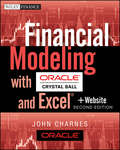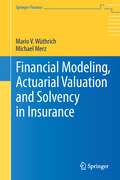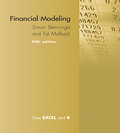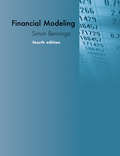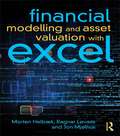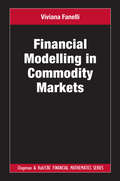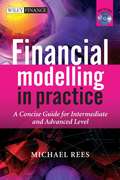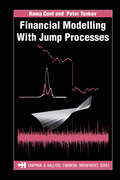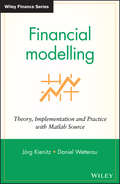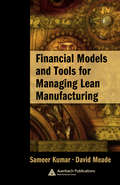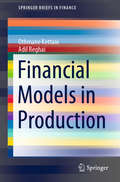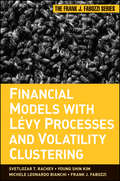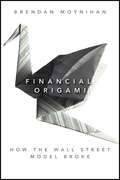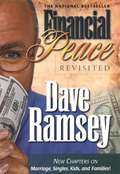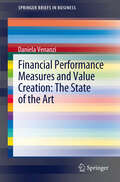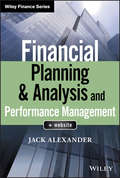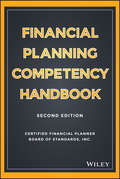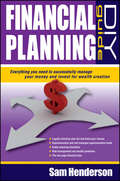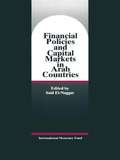- Table View
- List View
Financial Modeling with Crystal Ball and Excel
by John CharnesPraise forFinancial Modeling with Crystal Ball(r) and Excel(r)"Professor Charnes's book drives clarity into applied Monte Carlo analysis using examples and tools relevant to real-world finance. The book will prove useful for analysts of all levels and as a supplement to academic courses in multiple disciplines."-Mark Odermann, Senior Financial Analyst, Microsoft"Think you really know financial modeling? This is a must-have for power Excel users. Professor Charnes shows how to make more realistic models that result in fewer surprises. Every analyst needs this credibility booster."-James Franklin, CEO, Decisioneering, Inc."This book packs a first-year MBA's worth of financial and business modeling education into a few dozen easy-to-understand examples. Crystal Ball software does the housekeeping, so readers can concentrate on the business decision. A careful reader who works the examples on a computer will master the best general-purpose technology available for working with uncertainty."-Aaron Brown, Executive Director, Morgan Stanley, author of The Poker Face of Wall Street"Using Crystal Ball and Excel, John Charnes takes you step by step, demonstrating a conceptual framework that turns static Excel data and financial models into true risk models. I am astonished by the clarity of the text and the hands-on, step-by-step examples using Crystal Ball and Excel; Professor Charnes is a masterful teacher, and this is an absolute gem of a book for the new generation of analyst."-Brian Watt, Chief Operating Officer, GECC, Inc."Financial Modeling with Crystal Ball and Excel is a comprehensive, well-written guide to one of the most useful analysis tools available to professional risk managers and quantitative analysts. This is a must-have book for anyone using Crystal Ball, and anyone wanting an overview of basic risk management concepts."-Paul Dietz, Manager, Quantitative Analysis, Westar Energy"John Charnes presents an insightful exploration of techniques for analysis and understanding of risk and uncertainty in business cases. By application of real options theory and Monte Carlo simulation to planning, doors are opened to analysis of what used to be impossible, such as modeling the value today of future project choices."-Bruce Wallace, Nortel
Financial Modeling with Crystal Ball and Excel (Wiley Finance #341)
by John CharnesPraise for Financial Modeling with Crystal Ball(r) and Excel(r) "Professor Charnes's book drives clarity into applied Monte Carlo analysis using examples and tools relevant to real-world finance. The book will prove useful for analysts of all levels and as a supplement to academic courses in multiple disciplines." -Mark Odermann, Senior Financial Analyst, Microsoft "Think you really know financial modeling? This is a must-have for power Excel users. Professor Charnes shows how to make more realistic models that result in fewer surprises. Every analyst needs this credibility booster." -James Franklin, CEO, Decisioneering, Inc. "This book packs a first-year MBA's worth of financial and business modeling education into a few dozen easy-to-understand examples. Crystal Ball software does the housekeeping, so readers can concentrate on the business decision. A careful reader who works the examples on a computer will master the best general-purpose technology available for working with uncertainty." -Aaron Brown, Executive Director, Morgan Stanley, author of The Poker Face of Wall Street "Using Crystal Ball and Excel, John Charnes takes you step by step, demonstrating a conceptual framework that turns static Excel data and financial models into true risk models. I am astonished by the clarity of the text and the hands-on, step-by-step examples using Crystal Ball and Excel; Professor Charnes is a masterful teacher, and this is an absolute gem of a book for the new generation of analyst." -Brian Watt, Chief Operating Officer, GECC, Inc. "Financial Modeling with Crystal Ball and Excel is a comprehensive, well-written guide to one of the most useful analysis tools available to professional risk managers and quantitative analysts. This is a must-have book for anyone using Crystal Ball, and anyone wanting an overview of basic risk management concepts." -Paul Dietz, Manager, Quantitative Analysis, Westar Energy "John Charnes presents an insightful exploration of techniques for analysis and understanding of risk and uncertainty in business cases. By application of real options theory and Monte Carlo simulation to planning, doors are opened to analysis of what used to be impossible, such as modeling the value today of future project choices." -Bruce Wallace, Nortel
Financial Modeling, Actuarial Valuation and Solvency in Insurance
by Mario V. Wüthrich Michael MerzRisk management for financial institutions is one of the key topics the financial industry has to deal with. The present volume is a mathematically rigorous text on solvency modeling. Currently, there are many new developments in this area in the financial and insurance industry (Basel III and Solvency II), but none of these developments provides a fully consistent and comprehensive framework for the analysis of solvency questions. Merz and Wüthrich combine ideas from financial mathematics (no-arbitrage theory, equivalent martingale measure), actuarial sciences (insurance claims modeling, cash flow valuation) and economic theory (risk aversion, probability distortion) to provide a fully consistent framework. Within this framework they then study solvency questions in incomplete markets, analyze hedging risks, and study asset-and-liability management questions, as well as issues like the limited liability options, dividend to shareholder questions, the role of re-insurance, etc. This work embeds the solvency discussion (and long-term liabilities) into a scientific framework and is intended for researchers as well as practitioners in the financial and actuarial industry, especially those in charge of internal risk management systems. Readers should have a good background in probability theory and statistics, and should be familiar with popular distributions, stochastic processes, martingales, etc.
Financial Modeling, fifth edition
by Simon Benninga Tal MofkadiA substantially updated new edition of the essential text on financial modeling, with revised material, new data, and implementations shown in Excel, R, and Python.Financial Modeling has become the gold-standard text in its field, an essential guide for students, researchers, and practitioners that provides the computational tools needed for modeling finance fundamentals. This fifth edition has been substantially updated but maintains the straightforward, hands-on approach, with an optimal mix of explanation and implementation, that made the previous editions so popular. Using detailed Excel spreadsheets, it explains basic and advanced models in the areas of corporate finance, portfolio management, options, and bonds. This new edition offers revised material on valuation, second-order and third-order Greeks for options, value at risk (VaR), Monte Carlo methods, and implementation in R. The examples and implementation use up-to-date and relevant data. Parts I to V cover corporate finance topics, bond and yield curve models, portfolio theory, options and derivatives, and Monte Carlo methods and their implementation in finance. Parts VI and VII treat technical topics, with part VI covering Excel and R issues and part VII (now on the book&’s auxiliary website) covering Excel&’s programming language, Visual Basic for Applications (VBA), and Python implementations. Knowledge of technical chapters on VBA and R is not necessary for understanding the material in the first five parts. The book is suitable for use in advanced finance classes that emphasize the need to combine modeling skills with a deeper knowledge of the underlying financial models.
Financial Modeling, fourth edition (The\mit Press Ser.)
by Simon BenningaA substantially revised edition of a bestselling text combining explanation and implementation using Excel; for classroom use or as a reference for finance practitioners. Financial Modeling is now the standard text for explaining the implementation of financial models in Excel. This long-awaited fourth edition maintains the “cookbook” features and Excel dependence that have made the previous editions so popular. As in previous editions, basic and advanced models in the areas of corporate finance, portfolio management, options, and bonds are explained with detailed Excel spreadsheets. Sections on technical aspects of Excel and on the use of Visual Basic for Applications (VBA) round out the book to make Financial Modeling a complete guide for the financial modeler.The new edition of Financial Modeling includes a number of innovations. A new section explains the principles of Monte Carlo methods and their application to portfolio management and exotic option valuation. A new chapter discusses term structure modeling, with special emphasis on the Nelson-Siegel model. The discussion of corporate valuation using pro forma models has been rounded out with the introduction of a new, simple model for corporate valuation based on accounting data and a minimal number of valuation parameters.New print copies of this book include a card affixed to the inside back cover with a unique access code. Access codes are required to download Excel worksheets and solutions to end-of-chapter exercises. If you have a used copy of this book, you may purchase a digitally-delivered access code separately via the Supplemental Material link on this page. If you purchased an e-book, you may obtain a unique access code by emailing digitalproducts-cs@mit.edu or calling 617-253-2889 or 800-207-8354 (toll-free in the U.S. and Canada).Praise for earlier editions“Financial Modeling belongs on the desk of every finance professional. Its no-nonsense, hands-on approach makes it an indispensable tool.”—Hal R. Varian, Dean, School of Information Management and Systems, University of California, Berkeley“Financial Modeling is highly recommended to readers who are interested in an introduction to basic, traditional approaches to financial modeling and analysis, as well as to those who want to learn more about applying spreadsheet software to financial analysis."—Edward Weiss, Journal of Computational Intelligence in Finance“Benninga has a clear writing style and uses numerous illustrations, which make this book one of the best texts on using Excel for finance that I've seen.”—Ed McCarthy, Ticker Magazine
Financial Modelling and Asset Valuation with Excel
by Morten Helbæk Ragnar Løvaas Jon Olav MjølhusFinance is Excel! This book takes you straight into the fascinating world of Excel, the powerful tool for number crunching. In a clear cut language it amalgamates financial theory with Excel providing you with the skills you need to build financial models for private or professional use. A comprehensive knowledge of modeling in Excel is becoming increasingly important in a competitive labour market. The chapters in part one start with the most basic Excel topics such as cell addresses, workbooks, basic formulas, etc. These chapters get more advanced through part one, and takes you in the end to topics such as array formulas, data tables, pivot tables, etc. The other parts of the book discusses a variety of subjects such as net present value, internal rate of return, risk, portfolio theory, CAPM, VaR, project valuation, asset valuation, firm valuation, loan, leasing, stocks, bonds, options, simulation, sensitivity analysis, etc.
Financial Modelling in Commodity Markets (Chapman and Hall/CRC Financial Mathematics Series)
by Viviana FanelliFinancial Modelling in Commodity Markets provides a basic and self-contained introduction to the ideas underpinning financial modelling of products in commodity markets. The book offers a concise and operational vision of the main models used to represent, assess and simulate real assets and financial positions related to the commodity markets. It discusses statistical and mathematical tools important for estimating, implementing and calibrating quantitative models used for pricing and trading commodity-linked products and for managing basic and complex portfolio risks. Key features: Provides a step-by-step guide to the construction of pricing models, and for the applications of such models for the analysis of real data Written for scholars from a wide range of scientific fields, including economics and finance, mathematics, engineering and statistics, as well as for practitioners Illustrates some important pricing models using real data sets that will be commonly used in financial markets
Financial Modelling in Practice
by Michael ReesFinancial Modelling in Practice: A Concise Guide for Intermediate and Advanced Level is a practical, comprehensive and in-depth guide to financial modelling designed to cover the modelling issues that are relevant to facilitate the construction of robust and readily understandable models.Based on the authors extensive experience of building models in business and finance, and of training others how to do so this book starts with a review of Excel functions that are generally most relevant for building intermediate and advanced level models (such as Lookup functions, database and statistical functions and so on). It then discusses the principles involved in designing, structuring and building relevant, accurate and readily understandable models (including the use of sensitivity analysis techniques) before covering key application areas, such as the modelling of financial statements, of cash flow valuation, risk analysis, options and real options. Finally, the topic of financial modelling using VBA is treated. Practical examples are used throughout and model examples are included in the attached CD-ROM.Aimed at intermediate and advanced level modellers in Excel who wish to extend and consolidate their knowledge, this book is focused, practical, and application-driven, facilitating knowledge to build or audit a much wider range of financial models.Note: CD-ROM/DVD and other supplementary materials are not included as part of eBook file.
Financial Modelling with Jump Processes (Chapman and Hall/CRC Financial Mathematics Series)
by Rama Cont Peter TankovWINNER of a Riskbook.com Best of 2004 Book Award!During the last decade, financial models based on jump processes have acquired increasing popularity in risk management and option pricing. Much has been published on the subject, but the technical nature of most papers makes them difficult for nonspecialists to understand, and the mathematic
Financial Modelling: Theory, Implementation and Practice with MATLAB Source (The Wiley Finance Series)
by Daniel Wetterau Joerg KienitzFinancial Modelling - Theory, Implementation and Practice is a unique combination of quantitative techniques, the application to financial problems and programming using Matlab. The book enables the reader to model, design and implement a wide range of financial models for derivatives pricing and asset allocation, providing practitioners with complete financial modelling workflow, from model choice, deriving prices and Greeks using (semi-) analytic and simulation techniques, and calibration even for exotic options.The book is split into three parts. The first part considers financial markets in general and looks at the complex models needed to handle observed structures, reviewing models based on diffusions including stochastic-local volatility models and (pure) jump processes. It shows the possible risk neutral densities, implied volatility surfaces, option pricing and typical paths for a variety of models including SABR, Heston, Bates, Bates-Hull-White, Displaced-Heston, or stochastic volatility versions of Variance Gamma, respectively Normal Inverse Gaussian models and finally, multi-dimensional models. The stochastic-local-volatility Libor market model with time-dependent parameters is considered and as an application how to price and risk-manage CMS spread products is demonstrated.The second part of the book deals with numerical methods which enables the reader to use the models of the first part for pricing and risk management, covering methods based on direct integration and Fourier transforms, and detailing the implementation of the COS, CONV, Carr-Madan method or Fourier-Space-Time Stepping. This is applied to pricing of European, Bermudan and exotic options as well as the calculation of the Greeks. The Monte Carlo simulation technique is outlined and bridge sampling is discussed in a Gaussian setting and for Lévy processes. Computation of Greeks is covered using likelihood ratio methods and adjoint techniques. A chapter on state-of-the-art optimization algorithms rounds up the toolkit for applying advanced mathematical models to financial problems and the last chapter in this section of the book also serves as an introduction to model risk. The third part is devoted to the usage of Matlab, introducing the software package by describing the basic functions applied for financial engineering. The programming is approached from an object-oriented perspective with examples to propose a framework for calibration, hedging and the adjoint method for calculating Greeks in a Libor Market model.Source code used for producing the results and analysing the models is provided on the author's dedicated website, http://www.mathworks.de/matlabcentral/fileexchange/authors/246981
Financial Models and Tools for Managing Lean Manufacturing (Supply Chain Integration Modeling, Optimization and Application)
by David MeadeThe effect Lean Manufacturing programs have on profit and loss statements during the early months of their implementation often causes them to be viewed as failures. The length of time it will take traditional financial reports to reflect lean manufacturing improvements depends upon how poorly the operation was doing in terms of inventory managemen
Financial Models in Production (SpringerBriefs in Finance)
by Adil Reghai Othmane KettaniThis book provides a hands-on guide to how financial models are actually implemented and used in practice, on a daily basis, for pricing and risk-management purposes. It shows how to put these models into use in production while minimizing the cost of implementation and maximizing robustness and control. Addressing some of the most important and cutting-edge issues, it describes how to build the necessary models in order to risk manage all the costs involved in options fabrication within the world of equity derivatives and hybrids. This is achieved by extending classical models and improving them in order to account for complex features. The book is primarily aimed at market practitioners (traders, risk managers, risk control, top managers), as well as Masters students in Quantitative/Mathematical Finance. It will also be useful for instructors hoping to enrich their courses with practical examples. The prerequisites are basic stochastic calculus and a general knowledge of financial markets and financial derivatives.
Financial Models with Levy Processes and Volatility Clustering
by Svetlozar T. Rachev Frank J. Fabozzi Michele L. Bianchi Young Shin KimAn in-depth guide to understanding probability distributions and financial modeling for the purposes of investment managementIn Financial Models with Lévy Processes and Volatility Clustering, the expert author team provides a framework to model the behavior of stock returns in both a univariate and a multivariate setting, providing you with practical applications to option pricing and portfolio management. They also explain the reasons for working with non-normal distribution in financial modeling and the best methodologies for employing it.The book's framework includes the basics of probability distributions and explains the alpha-stable distribution and the tempered stable distribution. The authors also explore discrete time option pricing models, beginning with the classical normal model with volatility clustering to more recent models that consider both volatility clustering and heavy tails.Reviews the basics of probability distributionsAnalyzes a continuous time option pricing model (the so-called exponential Lévy model)Defines a discrete time model with volatility clustering and how to price options using Monte Carlo methodsStudies two multivariate settings that are suitable to explain joint extreme eventsFinancial Models with Lévy Processes and Volatility Clustering is a thorough guide to classical probability distribution methods and brand new methodologies for financial modeling.
Financial Organization and Operations of the IMF
by International Monetary FundA report from the International Monetary Fund.
Financial Origami
by Brendan MoynihanAn in-depth look at the failure of Wall Street's "proven" financial models Origami is the Japanese art of folding paper into intricate and aesthetically attractive shapes. As such, it is the perfect metaphor for the Wall Street financial engineering model, which ultimately proved to be the underlying cause of the 2008 financial crisis. In Financial Origami, Brendan Moynihan describes how the Wall Street business model evolved from a method to transfer risk into a method for manufacturing risk. Along the way, this timely book skillfully dissects financial engineering and addresses how it's often a mechanism to evade regulatory constraints, provide institutional investors with customized products, and, of course, generate revenue for financial engineers. Reveals how Wall Street's financial engineering business model morphed into something destructive Highlights how the origami model worked well in the comparatively stable years of the early 2000s, when there was less risk to transfer Discusses how Wall Street began manufacturing risk by creating products that multiplied risk exposures and encouraged subprime lending With the collapse of Lehman Brother the Wall Street business model effectively broke. But there are many lessons to be learned from what has transpired, and Financial Origami will show you what they are.
Financial Peace Revisited
by Dave RamseyDave Ramsey knows what it's like to have it all. By age twenty-six, he had established a four-million-dollar real estate portfolio, only to lose it by age thirty. He has since rebuilt his financial life and, through his workshops and his New York Times business bestsellers Financial Peace and More than Enough, he has helped hundreds of thousands of people to understand the forces behind their financial distress and how to set things right--financially, emotionally, and spiritually. In this new edition of Financial Peace, Ramsey has updated his tactics and philosophy to show even more readers: how to get out of debt and stay out, the KISS rule of investing--"Keep It Simple, Stupid" how to use the principle of contentment to guide financial decision making how the flow of money can revolutionize relationships. With practical and easy to follow methods and personal anecdotes, Financial Peace is the road map to personal control, financial security, a new, vital family dynamic, and lifetime peace.
Financial Peace Revisited: New Chapters on Marriage, Singles, Kids and Families
by Dave RamseyDave Ramsey knows what it's like to have it all. By age twenty-six, he had established a four-million-dollar real estate portfolio, only to lose it by age thirty. He has since rebuilt his financial life and, through his workshops and his New York Times business bestsellers Financial Peace and More than Enough, he has helped hundreds of thousands of people to understand the forces behind their financial distress and how to set things right-financially, emotionally, and spiritually.In this new edition of Financial Peace, Ramsey has updated his tactics and philosophy to show even more readers:how to get out of debt and stay outthe KISS rule of investing--"Keep It Simple, Stupid"how to use the principle of contentment to guide financial decision makinghow the flow of money can revolutionize relationshipsWith practical and easy to follow methods and personal anecdotes, Financial Peace is the road map to personal control, financial security, a new, vital family dynamic, and lifetime peace.
Financial Performance Measures and Value Creation: the State of the Art
by Daniela VenanziThe choice of financial performance measures is one of the most critical challenges facing organizations. The accounting-based measures of financial performance have been viewed as inadequate, as firms began focusing on shareholder value as the primary long-term objective of the organization. Hence, value-based metrics were devised that explicitly incorporate the cost of capital into performance calculations. Despite the increasing emphasis on these value-based measures, no definitive evidence exists of which metric works better than others, and on the extent to which any of them is superior to traditional accounting measures. In this scenario, the objective of this book is contributing to the ongoing dialogue on the appropriateness of different financial performance measures, by providing a systematic and updated review of the major value-based measures, by highlighting their respective strengths and weaknesses and by comparing the main international empirical evidence on their effectiveness. This book can be a powerful tool for guiding managers and graduate students in the "tangled forest" of the existing metrics, by providing them with the quick, but adequate knowledge for consistently adopting them.
Financial Perspective
by Robert S. Kaplan David P. NortonFinancial objectives represent the long-term goal of the organization: to provide superior returns based on the capital invested in the unit. Building a Balanced Scorecard should encourage business units to link their financial objectives to corporate strategy. This chapter looks at the dual role financial objectives and measures must play, defining the financial performance expected from the strategy, and serving as the ultimate targets for the objectives and measures of all the other scorecard perspectives. This chapter was originally published as chapter 3 of "The Balanced Scorecard: Translating Strategy into Action."
Financial Planning & Analysis and Performance Management (Wiley Finance)
by Jack AlexanderCritical insights for savvy financial analysts Financial Planning & Analysis and Performance Management is the essential desk reference for CFOs, FP&A professionals, investment banking professionals, and equity research analysts. With thought-provoking discussion and refreshing perspective, this book provides insightful reference for critical areas that directly impact an organization’s effectiveness. From budgeting and forecasting, analysis, and performance management, to financial communication, metrics, and benchmarking, these insights delve into the cornerstones of business and value drivers. Dashboards, graphs, and other visual aids illustrate complex concepts and provide reference at a glance, while the author’s experience as a CFO, educator, and general manager leads to comprehensive and practical analytical techniques for real world application. Financial analysts are under constant pressure to perform at higher and higher levels within the realm of this consistently challenging function. Though areas ripe for improvement abound, true resources are scarce—until now. This book provides real-world guidance for analysts ready to: Assess performance of FP&A function and develop improvement program Improve planning and forecasting with new and provocative thinking Step up your game with leading edge analytical tools and practical solutions Plan, analyze and improve critical business and value drivers Build analytical capability and effective presentation of financial information Effectively evaluate capital investments in uncertain times The most effective analysts are those who are constantly striving for improvement, always seeking new solutions, and forever in pursuit of enlightening resources with real, useful information. Packed with examples, practical solutions, models, and novel approaches, Financial Planning & Analysis and Performance Management is an invaluable addition to the analyst’s professional library. Access to a website with many of the tools introduced are included with the purchase of the book.
Financial Planning Competency Handbook
by Cfp BoardThe official guide for exam success and career excellence Financial Planning Competency Handbook, Second Edition is the essential reference for those at any stage of certification and a one-stop resource for practitioners looking to better serve their clients. This fully updated second edition includes brand new content on connections diagrams, new case studies, and new instructional videos, and a completely new section devoted to the interdisciplinary nature of financial planning. You'll gain insights from diverse fields like psychology, behavioral finance, communication, and marriage and family therapy to help you better connect with and guide your clients, alongside the detailed financial knowledge you need to perform to the highest expectations as a financial planner. This book contains over ninety chapters that are essential for practitioners, students, and faculty. Whether a practitioner, student, or faculty member, this guide is the invaluable reference you need at your fingertips. Comprehensive, clear, and detailed, this handbook forms the foundation of the smart financial planner's library. Each jurisdiction has its own laws and regulations surrounding financial planning, but the information in this book represents the core body of knowledge the profession demands no matter where you practice. Financial Planning Competency Handbook, Second Edition guides you from student to practitioner and far beyond, with the information you need when you need it.
Financial Planning DIY Guide: Everything You Need to Successfully Manage Your Money and Invest for Wealth Creation
by Sam HendersonFinancial Planning DIY Guide is the only Australian all-in-one handbook to getting the most from your money. Written by expert financial planner Sam Henderson, this comprehensive guide will help you build and manage your assets no matter what your stage of life, and show you how to create your own one-page financial plan and put it into practice.
Financial Planning, Budgeting and Forecasting/Financial Intelligence Collection
by David A. Moss Karen Berman Joe Knight Jeremy Hope Robin Fraser Joseph H. EllisDon’t let your fear of finance get in the way of your success. This digital collection, curated by Harvard Business Review, brings together everything a manager needs to know about financial intelligence. It includes Financial Intelligence, called a “must-read” for decision makers without expertise in finance; A Concise Guide to Macroeconomics, which covers the essentials of macroeconomics and examines the core ideas of output, money, and expectations; Essentials of Finance and Budgeting, which explains everything HR professionals need to know to make wise financial decisions; Ahead of the Curve, Joseph H. Ellis’s forecasting method to help managers and investors understand and predict the economic cycles that control their businesses and financial fates; Beyond Budgeting; which offers a coherent management model that overcomes the limitations of traditional budgeting; Preparing a Budget, packed with handy tools, self-tests, and real life examples to help you hone critical skills; and HBR Guide to Finance Basics for Managers, which will give you the tools and confidence you need to master the fundamentals of finance.
Financial Policies and Capital Markets Arab Countries
by Said El-NaggarA report from the International Monetary Fund.
Financial Policy at Apple, 2013 (A)
by Mihir A. Desai Elizabeth A. MeyerBy the end of 2013, Apple had $137 billion dollars in cash and marketable securities. This case explores how companies can generate such large amounts of cash and how and if they should distribute it to shareholders, especially in the face of shareholder pressure. In the process, students are asked to undertake fundamental financial analyses, including ratio analysis, a financial forecast, and a cash distribution analysis.
